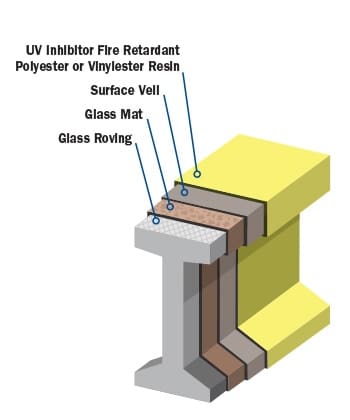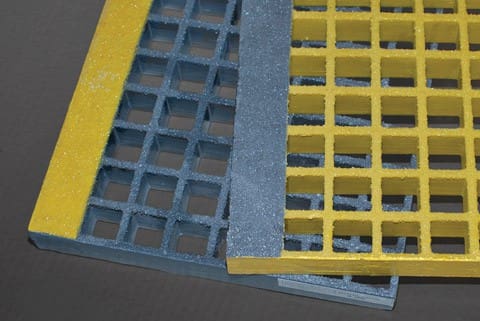Whether it’s pultruded or molded, fiberglass-reinforced plastic (FRP) grating offers a strong yet lightweight solution perfect for commercial and industrial applications like floor systems, walkways, work platforms, stairs, ramps, trench covers and catwalks. More durable than steel bar grating, FRP grating features include corrosion, moisture and fire resistance, nonconductive and thermal insulating properties, and dimensional stability. FRP grating is much lighter than steel grating, making it easier to install and remove when access is needed below it. And because of its exceptional durability, FRP grating is extremely low maintenance — keeping operational costs for ongoing upkeep minimal.
But besides all these commonalities, there are some key differences between molded and pultruded grating.

Molded FRP Grating
Molded grating typically has a square mesh pattern, but it can also be cast in a rectangular mesh configuration. Molded FRP grating panels are also cast in one piece — meaning that there is no mechanical joint between bearing bars. This gives the grating exceptional bi-directional strength, aiding in its ability to offer a substantial load capacity. In addition, the surface of the grating can either come with a meniscus — or concave — surface or with a quartz grit slip-resistant surface for added safety. A covered grating surface is also an option for preventing objects and substances from falling to lower levels and for creating an odor barrier.
The Molding Process
When molded grating is created, layers of liquid resin and continuous fiberglass rovings are laid one after the other in a mold until the desired thickness and panel dimensions have been achieved. Once this is done, the mold is set aside to cure. When the curing process is complete, the panel is removed from the mold.
Bedford’s stringent quality control processes ensure that each piece of molded grating will provide superior durability. Additionally, the high resin-to-glass ratio (approximately 65% resin to 35% glass by weight) provides excellent service life, even in the most demanding applications.

Pultruded FRP Grating
Where molded grating is a single panel of resin and fiberglass layers, pultruded grating is composed of a series of parallel bearing bars — with either a T- or I-shaped profile — kept in place by several perpendicular cross-rods. The closer the bars are placed together, the stronger the pultruded grating panel is.
Besides being unidirectional in strength, pultruded grating can support heavier loads and longer spans than comparably sized molded grating — making it ideal for more demanding applications. This is because the continuous glass rovings in pultruded grating helps resist tension, compression and bending while providing longitudinal strength. The continuous glass mat also increases the grating’s transverse strength and resistance to impact.
How Pultruded Grating Is Made
From the pultrusion process to assembly, pultruded grating goes through a series of manufacturing steps before it reaches its final form.
Step 1: Reinforcement
The pultrusion process typically starts by pulling in two forms of fiberglass reinforcement. Creels of fiberglass roving provide unidirectional strength along the length of the profile while rolls of woven fiberglass mat provide multidirectional reinforcement. All reinforcements are fed through preforming guides that will begin to shape the raw glass fibers into the final bearing bar profile for the grating.
Step 2: Impregnation and Resin Bath
The fiberglass reinforcements are pulled through a bath of thermoset resin mix — typically polyester or vinylester — blended with pigments to add color, fillers and additives to enhance properties, and catalysts to aid in curing. The resin mix will soak and permeate the glass reinforcements, which is called impregnation or “wet out.” The resin will help in holding the glass reinforcement together and transferring the load between fibers. It also plays an important role in protecting the final product from corrosion and UV rays.
Step 3: Surface Veil
Just before all the fiberglass material is pulled into the heated die, a lightweight polyester fabric — also called a surface veil — is added. The surface veil helps provide a smooth, more durable resin-rich surface in the final product — enhancing the product’s environmental and chemical resistance. The surface veil does not, however, provide additional structural strength.
Step 4: Curing and Cutting
After the surface veil is added, wet-out reinforcements are pulled through the heated pultrusion die, which begins the thermosetting process — causing the resin to “cure” or harden. By the time the material exits the die, a solid bearing bar with a rigid T- or I-shaped profile will have been formed with all the reinforcements laminated inside. The cured bearing bar is then pulled to the cut-off saw and cut to the appropriate length.
Step 5: Assembly
Holes are drilled every six inches along the length of the bearing bars. The cross-rods are then inserted through the holes — perpendicular to the bearing bars — and secured with epoxy. Together, the bearing bars and cross-rods make up the grating panels.
The Key Differences
The biggest differences between molded and pultruded grating stem from the differing manufacturing process. The molding process allows molded grating to be produced in single, made-to-size panels with exceptional bi-directional strength. The pultrusion process, on the other hand, reduces potential errors in production — creating a consistent, high-strength FRP grating product. Pultruded grating can also support heavier loads and longer spans than comparably sized molded grating — despite being unidirectional in strength.
Additionally, while pultruded grating is the stronger and stiffer option, molded grating provides more flexibility, corrosion resistance and impact resistance. Watch the video for a more comprehensive comparison of these two types of grating.
Regardless of their key differences, both types of FRP grating feature exceptional durability and strength as opposed to more traditional building materials like steel. And when choosing between molded and pultruded grating, the main thing to consider is the type of application.
Looking for more information about Bedford’s molded and pultruded grating products? Contact us or browse the available resources below.
Learn more about our FRP Grating Products

FRP Grating Resources
Download the FRP grating catalog, data sheets and other technical documents from our Resources page.

Stair Treads and Stair Tread Covers
Bedford offers a variety of molded and pultruded grating stair tread panels that are easy to cut and quick to install.

FRP Grating Clips
Bedford offers several types of stainless steel and FRP fasteners to secure our molded and pultruded grating products in place.

FRP Grating Pedestals
For applications requiring an elevated grating floor system, Bedford offers a variety of adjustable and fixed pedestals.
FAQs
What is molded grating?
Molded grating typically features a square or rectangular mesh pattern. Molded FRP grating panels are also cast in one piece without a mechanical joint between bearing bars — giving the grating exceptional bi-directional strength.
What is pultruded grating?
Pultruded grating is composed of a series of parallel bearing bars — with either a T- or I-shaped profile — kept in place by several perpendicular cross-rods. The closer the bars are placed together, the more unidirectional strength the pultruded grating panel provides.
What's the difference between molded and pultruded grating?
The biggest difference between molded and pultruded grating is in the manufacturing process. The molding process allows molded grating to be produced in single, made-to-size panels with exceptional bi-directional strength. The pultrusion process creates a consistent, high-strength FRP grating product that can also support heavier loads and longer spans than comparably sized molded grating.